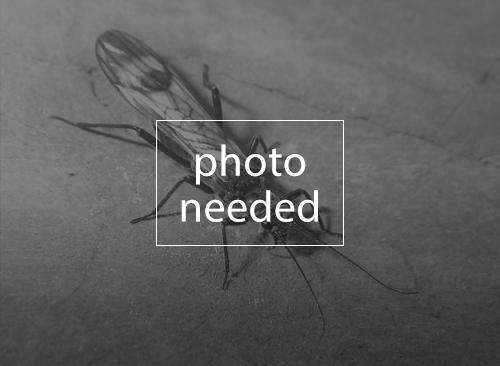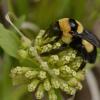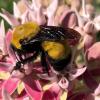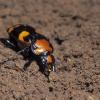
Hylaeus dimidiatus is a small bee endemic to the island of Hawaii in Hawaii. It is similar to the wet forest species in the dumetorum species group, differing by the larger facial marks and other details. It is known from two historical and two recent collections, and appears to be associated with the tree Chamaesyce olowaluana.
Males
Black; head all yellow below the antennae, legs and pronotum also marked with yellow. Hairs at the apex of the abdomen black, erect; process of the 8th sternum strongly dilated, triangular in lateral view. Body very narrow, gracile.
Females
Face sometimes with two small lateral dots, other marks as in the male. Hylaeus dimidiatus is one of the smallest Hawaiian species. In its small size and markings it superficially resembles species of the dumetorum group, most of which are found in wet forest. However, it lacks the smooth propodeum and grooved scape characteristic of that group. It is otherwise most similar to H. hula, which has a yellow mark on the scape and is more robust. Despite these similarities, genetic data (Magnacca 2005) has shown it to be very closely related to H. connectens, to which it bears little resemblance.
Taxonomic Status
Hylaeus dimidiatus was described as Nesoprosopis dimidiata by Perkins (1899). Nesoprosopis was reduced to a subgenus of Hylaeus by Meade-Waldo (1923). The most recent taxonomic treatment was Daly and Magnacca (2003).
Hylaeus dimidiatus inhabits dry to mesic forests. All recent collections have come from Chamaesyce olowaluana (akoko) trees. Nesting habits are not known, but based on related species it probably nests in wood.
Hylaeus dimidiatus is restricted to the upper-elevation dry and mesic forest belt in Kona and Kau. Only one (historic) collection is from Kau, but the area has not been searched recently. Recent collections are from the Puu Waawaa Wildlife Sanctuary and the Pohakuloa Training Area.
Xerces Red List Status: Critically Imperiled
Other Rankings:
Canada – Species at Risk Act: N/A
Canada – provincial status: N/A
Mexico: N/A
USA – Endangered Species Act: Species of Concern
USA – state status: HI: Species of Concern
NatureServe: GNR
IUCN Red List: N/A
This species is extremely rare; although it can be found in moderate numbers, it has a very narrow range. Originally, U.S. Federal listings of rare and endangered species classed H. dimidiatus as a “Category 2” Candidate Species about which more information was needed before it could be considered for listing. This status was based on recognition that Hawaiian bees in general were becoming rarer and little was known about their conservation status. Data were never gathered to document whether or not this species should be proposed for listing. It is currently considered to be a “Species of Concern” or a “Special Status Species” by the U.S. Fish and Wildlife Service and the Hawaii Division of Forestry and Wildlife.
The rarity of H. dimidiatus and lack of knowledge about its requirements make it difficult to assess threats. The habitat it lives in has been heavily impacted by grazing and other factors, but the large potential area and lack of access makes it difficult to assess how much remains, or what the true distribution of H. dimidiatus is. In general, Chamaesyce olowaluana appears to support a much larger bee fauna than is found in nearby forest. It is also extremely vulnerable to grazing by feral sheep, which prevents reproduction. As a result, there are relatively few trees in the Puu Waawaa area. Dependence on C. olowaluana may therefore be an important factor. Lack of nest sites due to declines in the populations of wood-boring Plagithmysus longhorn beetles may also be a factor, but has not been investigated.
The top priority is to identify extant populations and document the continued existence of the species. Both sites where H. dimidiatus is known to be found are protected under the auspices of the State of Hawaii or the U.S. Army, though they may not be actively managed for habitat conservation; other populations may be found on private land. The trees that H. dimidiatus were collected on at Puu Waawaa lie just outside a sheep fence; including them in the fenced area and/or planting C. olowaluana within the exclosure would help greatly. Both areas are highly vulnerable to fire. Research is needed in order to identify reasons for rarity, determine dependence on C. olowaluana, and locate new populations.
Daly, H. V., and K. N. Magnacca. 2003. Insects of Hawaii, Vol. 17: Hawaiian Hylaeus (Nesoprosopis) Bees (Hymenoptera: Apoidea). University of Hawaii Press, Honolulu. 234 pp.
Magnacca, K. N. 2005. Evolution of Hylaeus (Nesoprosopis) Bees in Hawaii. Ph.D. dissertation, Cornell University.
Meade-Waldo, G. 1923. Hymenoptera, fam. Apidae, subfam. Prosopidae, fasc. 181. Pp. 1-45 in P. Wytsman (ed.), Genera Insectorum. L. Desmet-Verteneuil, Brussels.
Perkins, R. C. L. 1899. Hymenoptera, Aculeata. Pp. 1-115 in D. Sharp (ed.), Fauna Hawaiiensis, Vol. 1. Cambridge University Press, Cambridge, United Kingdom.
Citation
Magnacca, K. N. 2005. Species Profile: Hylaeus dimidiatus. In Shepherd, M. D., D. M. Vaughan, and S. H. Black (Eds). Red List of Pollinator Insects of North America. CD-ROM Version 1 (May 2005). Portland, OR: The Xerces Society for Invertebrate Conservation.
Profile prepared by Karl Magnacca, USGS-BRD, Kilauea Field Station





